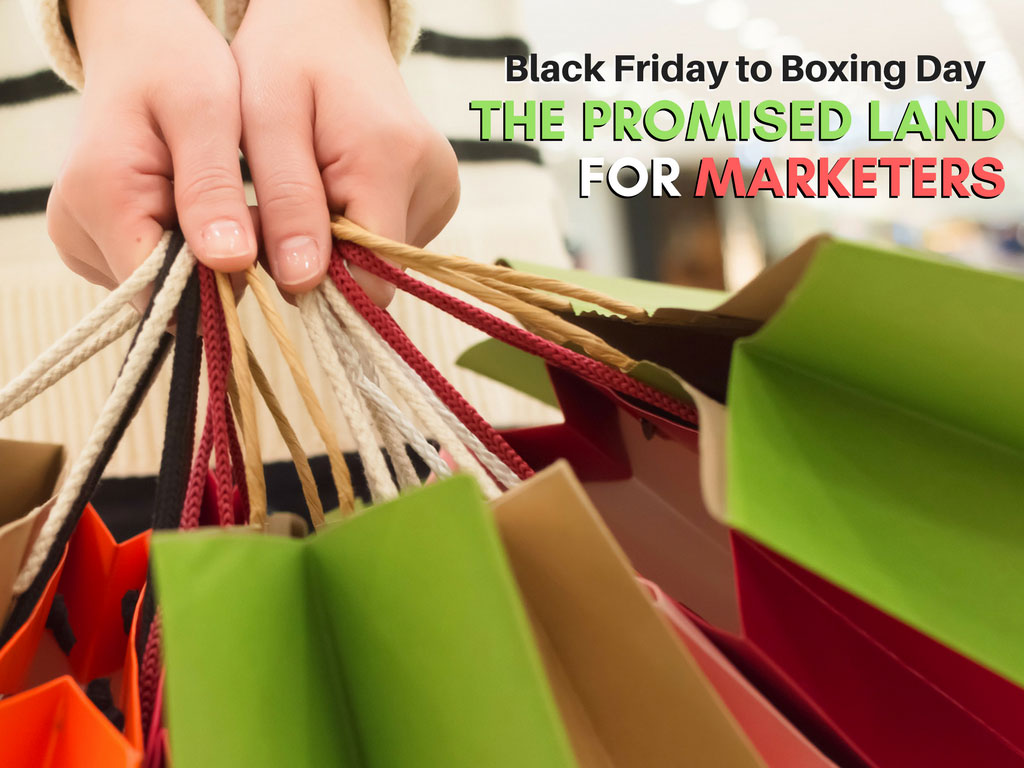Black Friday to Boxing Day – The Promised Land for Marketers
Black Friday, Cyber Monday, and Boxing Day are some of the most important days of the year for retailers in Canada. Today I’m going to share some tips and tricks gained through our experience with the hope that you can translate these learnings into success for your campaigns.

The History
Black Friday – Starting in 2005, retailers have been providing substantial discounts on their products, and consumers have been lining up outside stores for days to ensure they are 1st in line to get in on the deals and discounts. While this has traditionally been contained to brick and mortar stores, there is an increasing online presence from retailers on Black Friday, including online only exclusive deals.
Cyber Monday – The Monday that follows is now warmly referred to as Cyber Monday. This is where the online players capitalize and has shifted consumer behavior with many preferring the peace and quiet of ecommerce, to the chaotic Black Friday crowds.
Boxing Day – What started as a British extended holiday to spend more time with Family, evolved into a massive sales day for retailers over time. While this used to be the most important sales day of the year, Black Friday and Cyber Monday have become more prominent in recent times.
With an increasing number of people opting for the “shopping from your couch” experience, having a robust strategy for your online campaigns is a must to capitalize on the high intent shoppers.
Shopping for Insight
If you’re an ecommerce company, then Google Shopping campaigns should be an integral part of your strategy, especially during these peak sales periods. Here are a few tips to ensure that you are on track to maximize performance:
- Update Your Feed Regularly: The merchant center feeds are the backbone for your shopping campaigns, and keeping your feed up to date is imperative for a smooth execution. One of the main issues we see with the feeds is product disapproval due to a mismatch in the pricing and availability between the merchant center and the actual website. To counter this, the feeds must be regularly updated so that the pricing and availability in the feed matches the website. Supplementary feeds can also be used to achieve this.
- Feed Optimization: Optimizing your feed is another important step in this process. Unlike traditional search campaigns, which leverage keywords to reach the right audience, shopping campaigns rely on Google Merchant feed features such as title, description, and ID to match the right product to the customer’s search query. With Shopping, specific product attributes allow your product to show up for the specific search terms, thereby increasing the chances of conversion.
- Leverage Performing Products: A simple, but surefire way to improve Shopping performance is to increase the bids on your high performing products so that they receive better positions and visibility. It is also advisable that the budgets be reassigned from the non-performing categories and IDs to minimize waste and maximize revenue.
- Include Negative Keywords: We can’t select the keywords for which the shopping ads will show, but we can ensure that the ads don’t show up for irrelevant search terms. This helps improve the performance by making the product results more relevant for the user.
- High Quality Images: The product images are the first thing the user will notice in the Shopping space, so it is essential that high quality images are used to help your ad stand out amongst competitors.
Searching for Performance
Paid Search isn’t going anywhere anytime soon, so here’s a few tricks to help you maximize the effectiveness of those campaigns as well.
- Budgets: Keep a constant check on the campaign budgets and pacing. You wouldn’t want to lose out on valuable traffic and conversions due to the campaigns being limited by budget.
- Remove Automation: Disable enhanced CPC for these periods as it could have an adverse impact on the campaign performance as these days do not receive typical user behaviour.
- Speed up the Site: Improving the landing page response time for both desktop and mobile is critical in this peak period. Nothing is more annoying to the customer than a slow website, particularly when they are shopping with this type of intent. This also will improve the performance of your Search campaigns through improved quality score.
- Relevancy is Key: Ensure your messaging is relevant to the sale in the ad copy and ad extensions. We love using ‘countdown’ style ads as well because they add an element of urgency and increase the chance of a conversion.
Hunting for Results
Now that you are armed with a few tips and tricks for your Search and Shopping campaigns, I’d like to share some our experiences with Canada’s largest outdoor retailer, Cabela’s. In 2017, we drove a Return on Ad Spend (ROAS) of 20 and 23 for Black Friday and Cyber Monday respectively, and a ROAS of 18 for Boxing Day; all with large overall revenue increases year over year. Here’s what drove this stellar performance:
- Google Shopping is Integral: Shopping campaigns were responsible for 11% of the total revenue and 12% of the total transactions from the Google campaigns. If we were to exclude the brand campaigns on Paid Search, shopping accounted for 58% of the revenue and 65% of the transactions coming from Google.
- Mobile Rising: While Desktop continues to be the top device accounting for 62% of the transactions and the revenue, Mobile increased its presence this year accounting for 23% of the transactions and 22% of the revenue.
- Mobile Monday: Keeping with the “shopping from your couch” trend, we increased the bids for the mobile campaigns on Cyber Monday, which proved to be extremely effective. Cyber Monday mobile had an ROAS of about 16 as compared to the 4.5 for desktop on the same day.
- It’s the Little Things: Categories with a lower average order value drove the majority of the transactions, representing roughly 65% of the total transactions and 55% of the total revenue.
- Shifting Consumer Behaviour: For the first time ever, Cyber Monday outperformed Black Friday in terms of total online revenue and ROAS. We are shifting our budgets to capitalize on this next year.
Time to Shine!
I hope these tips, tricks, and learnings will be helpful as you plan your strategy for next year. We have certainly seen success through these methods, and learn something new every time we run these campaigns.
How was your Q4 in 2017? Please feel free to share your thoughts and experiences in the comments below.
